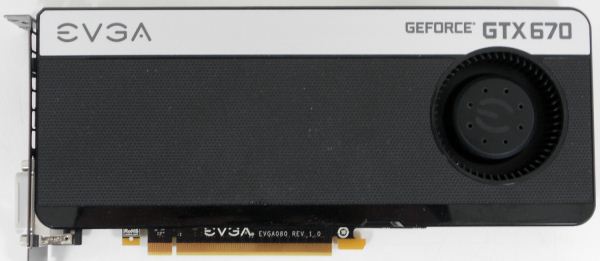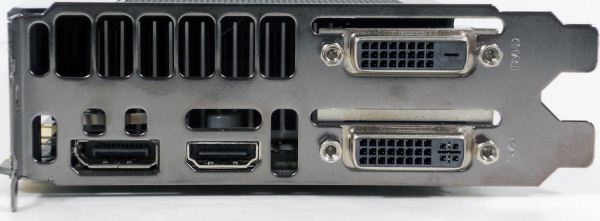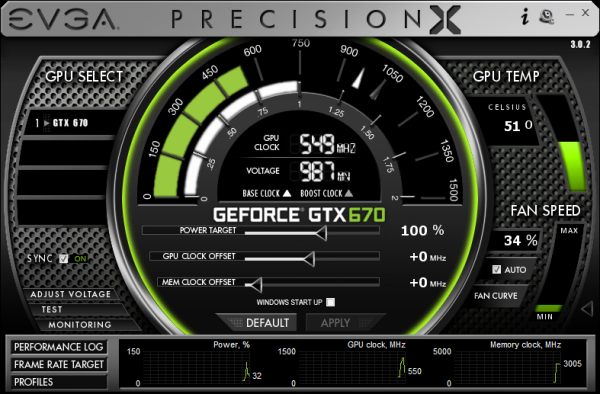NVIDIA GeForce GTX 670 Review Feat. EVGA: Bringing GK104 Down To $400
by Ryan Smith on May 10, 2012 9:00 AM ESTMeet The EVGA GeForce GTX 670 Superclocked
Our second card of the day is EVGA’s GeForce GTX 670 Superclocked, which in EVGA’s hierarchy is their first tier of factory overclocked cards. EVGA is binning GTX 670s and in turn promoting some of them to this tier, which means the GTX 670 Superclocked are equipped with generally better performing chips than the average reference card.
| GeForce GTX 670 Partner Card Specification Comparison | ||||
| EVGA GeForce GTX 670 Superclocked | GeForce GTX 670 (Ref) | |||
| CUDA Cores | 1344 | 1344 | ||
| Texture Units | 112 | 112 | ||
| ROPs | 32 | 32 | ||
| Base Clock | 967MHz | 915MHz | ||
| Boost Clock | 1046MHz | 980MHz | ||
| Memory Clock | 6210MHz | 6008MHz | ||
| Memory Bus Width | 256-bit | 256-bit | ||
| Frame Buffer | 2GB | 2GB | ||
| TDP | 170W | 170W | ||
| Manufacturing Process | TSMC 28nm | TSMC 28nm | ||
| Width | Double Slot | Double Slot | ||
| Length | 9.5" | 9.5" | ||
| Warranty | 3 Years | N/A | ||
| Price Point | $419 | $399 | ||
For the GTX 670 SC, EVGA has given both the core clock and memory clock a moderate boost. The core clock has been increased by 52MHz (6%) to 967MHz base and 66MHz (7%) boost to 1046MHz. Meanwhile the memory clock has been increased by 202MHz (3%) to 6210MHz.
Other than the clockspeed changes, the GTX 670 SC is an almost-reference card utilizing a reference PCB with a slightly modified cooler. EVGA is fabricating their own shroud, but they’ve copied NVIDIA’s reference shroud down to almost the last detail. The only functional difference is that the diameter of the fan intake is about 5mm less, otherwise the only difference is that EVGA has detailed it differently than NVIDIA and used some rounded corners in place of square corners.
The only other change you’ll notice is that EVGA is using their own high flow bracket in place of NVIDIA’s bracket. The high flow bracket cuts away as much metal as possible, maximizing the area of the vents. Though based on our power and temperature readings, this doesn’t seem to have notably impacted the GTX 670 SC.
While we’re on the matter of customized cards and factory overclocks, it’s worth reiterating NVIDIA’s position on factory overclocked cards. Reference and semi-custom cards (that is, cards using the reference PCB) must adhere to NVIDIA’s power target limits. For GTX 670 this is a 141W power target, with a maximum power target of 122% (170W). Fully custom cards with better power delivery circuitry can go higher, but not semi-custom cards. As a result the flexibility in building semi-custom cards comes down to binning. EVGA can bin better chips and use them in cards such as the Superclocked – such as our sample which can go 17 boost bins over the base clock versus 13 bins for our reference GTX 670 – but at the end of the day for stock performance they’re at the mercy of what can be accomplished within 141W/170W.
In any case, as the card is otherwise a reference GTX 670 EVGA is relying on the combination of their factory overclock, their toolset, and their strong reputation for support to carry the card. EVGA has priced the card at $419, $20 over the GTX 670 MSRP, in-line with other factory overclocked cards.
On the subject of pricing and warranties, since this is the first EVGA card we’ve reviewed since April 1st, this is a good time to go over the recent warranty changes EVGA has made.
Starting April 1st, EVGA has implemented what they’re calling their new Global Warranty Policy. Starting July 1st, 2011 (the policy is being backdated), all new EVGA cards ship with at least a 3 year warranty. And for the GTX 600 series specifically, so far EVGA has only offered models with a 3 year warranty in North America, which simplifies their product lineup.
To complement the 3 year warranty and replace the lack of longer term warranties, EVGA is now directly selling 2 and 7 year warranty extensions, for a total of 5 and 10 years respectively. So instead of buying a card with a 3 year warranty or a longer warranty, you’ll simply buy the 3 year card and then buy a warranty extension to go with it. However the extended warranty requires that the card be registered and the warranty purchased within 30 days.
The second change is that the base 3 year warranty no longer requires product registration. EVGA has other ways to entice buyers into registering, but they’ll now honor all applicable cards for 3 years regardless of the registration status. At the same time the base 3 year warranty is now a per-product warranty (e.g. a transferable warranty) rather than per-user warranty, so the base warranty will transfer to 2nd hand buyers. The extended warranties however will not.
The third change is how EVGA is actually going to handle the warranty process. First and foremost, EVGA is now allowing cards to be sent to the nearest EVGA RMA office rather than the office for the region the card was purchased from. For example a buyer moving from Europe to North America can send the card to EVGA’s North American offices rather than sending it overseas.
Finally, EVGA is now doing free cross shipping, alongside their existing Advanced RMA program. EVGA will now cross-ship replacement cards for free to buyers. The buyer meanwhile is responsible for paying to ship the faulty card back and putting up collateral on the new card until EVGA receives the old card.
There’s also one quick change to the step-up program that will impact some customers. With the move to purchasing extended warranties, the step-up program is only available to customers who either purchase an extended warranty or purchase an older generation card that comes with a lifetime warranty. Step-up is not available to cards with only the base 3 year warranty.
Moving on, along with EVGA’s new warranty EVGA is bundling the latest version of their GPU utilities, Precision X and OC Scanner X.
Precision X, as we touched upon quickly in our GTX 680 review, is the latest iteration of EVGA’s Precision overclocking & monitoring utility. It’s still based on RivaTuner and along with adding support for the GTX 600 series features (power targets, framerate caps, etc), it also introduces a new UI. Functionality wise it’s still at the top of the pack along with the similarly RivaTuner powered MSI Afterburner. Personally I’m not a fan of the new UI – circular UIs and sliders aren’t particularly easy to read – but it gets the job done.
OC Scanner X has also received a facelift and functionality upgrade of its own. Along with its basic FurMark-ish stress testing and error checking, it now also offers a basic CPU stress test and GPU benchmark.



















414 Comments
View All Comments
CeriseCogburn - Saturday, May 12, 2012 - link
Yes, too true for the ranters to respond to, and every gaming card is a want not a need.The node shrinking is beginning to reach it's limit anyway - were getting down to not very many rows of molecules literally in between paths to buffer electrical disturbances inside the chips that are beginning to cause uncontainable tunneling damage.
28nm is at about a 51 atoms thick lattice, with 22mn , 16mn, and 14mn reaching down to so delicate an about 26 atom thick buffer aside electron flow that dual layering, "tri-gate" other K materials, or some quantum mechanics plasma containment breakthrough is soon needed.
Given that level of amazing sophistication, and a coming near limit on node shrink due to reaching into counting atoms on both hands and feet that make up "the thickness of the wire protection", perhaps the pricing complainers need a bit more humility and thankfulness, instead of a constant demand of moar and faster and better for less.
Spunjji - Thursday, May 10, 2012 - link
Congratulations on missing the point.-slow clap-
I for one will be holding off on a purchase, because I don't feel like pissing my cash away on something that is not offering good value for money. That != expensive.
CeriseCogburn - Friday, May 11, 2012 - link
That person never missed any point.You for one appear to be the delay artist. You run around moaning and bitching about prices, when in fact what you really want is others to purchase now so you can suck up the discounts at a later date reaping the future competition crunch and resultant price drops available because the early purchasers you attacked made it all possible.
I don't have a problem with a person who bides their time and tries to score a deal when prices eventually drop. It does bother me though, when they go around forums biting the hand that is actually feeding them.
Enjoy your dried up second or third tier penny pincher second class when you can finally afford it.
SlyNine - Saturday, May 12, 2012 - link
I can complain about anything I want. But you're COMPLAINING about complainers. Which makes you kinda a hypocrite.CeriseCogburn - Sunday, May 13, 2012 - link
And you're complaining about a person complaining about complainers....See why, having some info and a real data point or a point on the cards reviewed relating to the current discussion in a post becomes important ?
This one has none.
Pantsu - Thursday, May 10, 2012 - link
At least in Germany it seems like the cheapest 7970 go for ~400€, and the same goes for GTX 670, so it's not so cut and dry win for the GTX 670 at least in Europe.It's a great card from Nvidia, and sure to drop the current prices to more reasonable level. I almost feel like I should've waited, but then again, I've already played with my 7970 for five months, I suppose that could be worth the 100€ it has lost from its value so far.
Morg. - Thursday, May 10, 2012 - link
My poor man, read the benchmarks. Even today the 7970 is a much better card, if only because it doesn't have the 2GB bottleneck that's gonna make you hurt one year from now.Spunjji - Thursday, May 10, 2012 - link
I'm still not sure I believe this RAM "bottleneck" argument. No way to know until a year from now, unfortunately.CeriseCogburn - Thursday, May 10, 2012 - link
It's already clear the cores are maxxed out - so no future game will be bringing some 2G vs 3G gaming advantage with these cards.Trying to crank it up enough and hack in 50 high rez textures into Skyrim in order to cause a frame rate drop on the 680 is as ephemeral as stable amd drivers, and just doesn't happen.
Common sense and the plain facts already make the answer absolutely clear to anyone who hasn't got a deranged mind scrubbed into fantasy by rampant fanboyism.
If lack of personal experience is the problem, a hundred reviews already have solved the riddle - the answer is the cores cannot push more - they puke out before the memory does.
"Enjoy" the "memory advantage" at "unplayable frame rates" and " 0 minimums" in a crawling, stuttering, frustrating "proof".
I'm certain a thousand morons will join the crusade and like religious zealouts claim victory as blood shoots from their eyes and they fall down in epilelptic seizure from the blinking monitor and zero to fifteen fps frames.
LOL
A victory indeed.
Pantsu - Thursday, May 10, 2012 - link
I've read and done benchmarks myself quite enough, thank you. I doubt there's going to be a bad bottleneck a year from now, and when 2 GB is not enough, a 7970 won't be enough either.In any case I wasn't referring to 670 being a better card, I would still buy a 7970 (custom one) since I play at 5760x1080, where it's faster than 680 when overclocked. But if I had waited for this five months, I could've saved maybe 150€. Oh well, it's not like consumer electronics is ever a good investment...